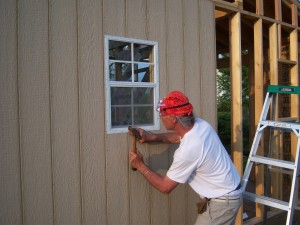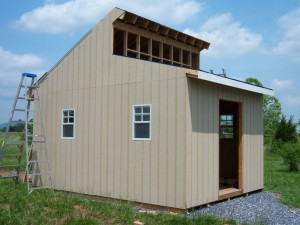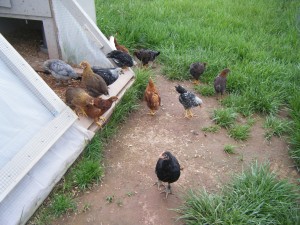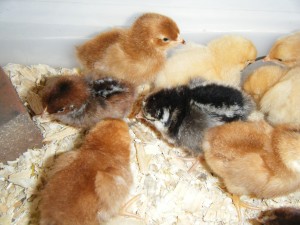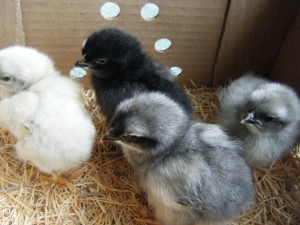Chickens
Ethel is sick
3We don’t know what happened, but Sunday night when we went to lock up the chickens, Ethel was laying by the door. She was concious, but not able to stand and her neck was twisted around in a very awkward looking way. We thought she might have had a broken neck. It has been so hot lately, we also thought she might have had heat stroke. We tried to get her cooled off and tried to get her to drink some water. She spent the night in a box in the basement and weren’t sure she would make it through the night. She did and has very slowly improved. We had to give her water several times a day, but she had no interest in food for the first 36 hours.
Finally, today she was drinking with little help and pecked at some melon and ate some meal worms. The prognosis is good at this point, but we still really don’t know what happened. She isn’t walking and only this evening did she even stand up on her own.

Chicken coop making progress
0When we decided that we wanted more chickens, we knew that we would also eventually need more living space for them. There are really three different types of space involved: interior space that is safe and weather protected, a ‘run’ that is safe from predators but is outside, and field space where they can wander around in the grass and scratch for treats like clover, bugs and worms.
First we thought we could build something like we built before only bigger. A couple of years ago we built two custom coops that can comfortably hold ten and five, respectively. With 16 chickens we were pretty much at capacity. A year ago we only had 12, but wanted to allow one of the hens, Tilda, to raise her own chicks. This worked out beautifully, but required the small coop as a nursery, leaving the remained 11 in the larger coop. This spring we got 20 more chickens, so we know we needed a lot more space.
So building a larger coop was our first option, but later we thought we might not have the time or initiative to design/build something ourselves. We researched pre-built coops only to find that they were rather expensive – even kits. We looked at generic pre-built sheds and realized that they were not quite what we wanted and still a bit expensive. We would have to modify a shed with better ventilation, more light, better access. an internal wall for storage, etc.
So back to the design/build option. We looked at lots of designs on the Internet and started to formulate our ideas. We really liked some designs with a clerestory wall with windows for light. That wall on the inside created the separation for a storage area. I bought a simple drafting/drawing program called Home Plan Pro and started to design the coop.
The design started with a 8′ by 12′ footprint, but quickly changed to 8′ by 14′, followed by 10′ by 16′, and finally 12′ by 16′. I liked the multiples of 4′. I was thinking in terms of sheets of plywood. It was a bit annoying each time I had to lengthen or widen the design, but we figured if we were going to all this trouble, we might as well make it big enough to provide room for all of our chickens as well as storage for their ‘stuff’. On paper it looked nice, but I didn’t fully appreciate its size until I put up the first walls. It was a lot taller than I imagined. I was using 8-ft studs for the walls, but lowered the design to 7′ 6″ so the siding would attach to something on the top and bottom.
The whole build process is on my Chicken Coop Picasa album. This includes everything from site prep to the shingles I put on yesterday.
Meanwhile, the original chickens and Tilda’s babies are all living in the original coop, the new babies (who are now about 7-weeks old) have moved outside to the nursery coop. We need the new chicken palace to be ready for action very soon. I haven’t even started to think about the run or the yard. The run will take some time as it needs framing and lots of hardware cloth. The yard will be perhaps 15,000 sq. ft. so will need quite a lot of perimeter wire fence. It will be a good day when this job is finished, the chickens are installed, and I am sitting in the yard with an ice tea enjoying the scene.

Chicks discover the world of ‘Outside’
0Wow! The chicks are growing so quickly! Their first home was a little plastic bin with a heat lamp in the bathroom and look at them now!
When they were a few weeks old we moved them to a what seemed like a huge pen in the basement, but they quickly outgrew that also. At about six weeks of age, we moved them to the ‘nursery’ coop outside. It’s a perfect place for young chickens to romp and play during the day and stay warm at night. They still have some feather growing to do, but with 20 of them to pile up together, they generate plenty of heat. They were as ready to be moved outside as I was to have them out of the house. What a mess they make! Even so, I was really worried about them for the first few nights. We went out to check on them a few times each evening and they seemed a little worried and not quite sure where to sleep so we had to gather up stragglers and put them in the sheltered area for the night. They caught on after a few nights and seem quite content now.
So after a week in the totally secure pen, this is their first outing into the fenced run surrounding the coop. What fun they had! So many new plants and bugs to try eating! They are large enough now that they can’t get through the run fencing and the area is all covered with netting to protect them from hawks. We will herd them back into the coop each evening so they are protected from nighttime predators.

Mail Order Mayhem
0
The other 14 chicks arrived a few days later, bringing this year’s flock to a total of 20. We have quite a variety – Partridge Rocks, Ameraucanas, Rhode Island Reds, Silver Laced Wyandots and a freebie who turned out to be an Egyptian Fayoumi rooster. There are also some Buff Orpington chicks in this photo that will be going to a friend’s farm.

Maran & Welsummer chicks
0
With plans to build a new chicken coop/palace this year, we ordered some new chicks to expand our flock. We ordered 4 Marans from a local farm, but when we went to pick them up and saw all the baby chicks, it was impossible to leave without 2 extra. We were interested in the Marans because they lay the darkest brown eggs and we really enjoy the range of colors. The extra chicks we picked up are Welsummers, which are another very dark brown egg layer.
